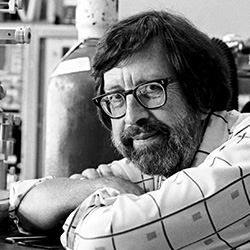Remembering Richard F. Thompson
September 6, 1930 – September 16, 2014
The world lost a neuroscience pioneer in September 2014 with the passing of APS Past President Richard F. Thompson. Widely regarded as a leading authority in his field, Dick focused his research on the broad field of behavioral neuroscience with a focus on the neurobiological substrates of learning and memory. He was the first neuroscientist to identify and map the neural circuits responsible for classical conditioning.
Dick was Keck Professor of Psychology and Biological Sciences at the University of Southern California and served as Director of the USC Neuroscience Program from 1989 to 2001. Subsequently, he served as senior scientific advisor to the USC Neuroscience Research Institute. He also held appointments as professor of neurology, School of Medicine, and senior research associate, School of Gerontology.
Before joining USC, Dick was a professor of human biology and psychology at Stanford University, where he chaired the Human Biology Program from 1980 to 1985. Previously, he served as professor of psychobiology in the University of California, Irvine, School of Biological Sciences; professor of psychology at Harvard University; and professor of medical psychology and psychiatry at the University of Oregon Medical School. He earned his PhD in Psychology at the University of Wisconsin–Madison, where he conducted his postdoctoral research in the neurophysiology laboratory. He also did postdoctoral work in the Laboratory of Neurophysiology at the University of Gothenburg in Sweden.
Dick did groundbreaking work that linked neural plasticity with behavioral plasticity. For example, using a spinal cord preparation while at UC Irvine, he studied and defined the processes of habituation and sensitization. At UC Irvine, he also began a long series of studies built on Russian psychologist Ivan Pavlov’s classical conditioning theory. Dick used the classically conditioned nictitating membrane/eyelid response model on rabbits to initially advance our understanding of hippocampal function during associative learning. But arguably his most famous work came in 1982 when he was at Stanford. There, he used the rabbit preparation to map the brain substrates of classical eye-blink conditioning. He made the seminal discovery that populations of neurons in the cerebellum were responsible for the acquisition and retention of the classical conditioning of discrete motor responses. This work was controversial, to say the least, as the cerebellum had long been considered strictly a motor region of the brain and not capable of demonstrating plasticity.
Dick continued his work at USC, where he was instrumental in bringing together many leading neuroscientists to form the nation’s first interdisciplinary neuroscience program. His research showed how the brain saves a memory by bolstering the connection between neurons. He also explored the effects of behavioral stress, estrogen, and aging on learning.
Dick published 450 research papers, served as editor of three journals, and authored several books — including the classic Foundations of Physiological Psychology (1967), which revolutionized the way that behavioral neuroscience was presented and learned.
He is also remembered as a stellar mentor, guiding the careers of many students and postdocs who are now leaders in the field of behavioral neuroscience. I was one of the beneficiaries of his skill as a mentor while I was a postdoctoral fellow in his laboratory at Stanford from 1983 to 1987. Perhaps above everything else, Dick taught me how to ask the important questions and how to design clever experiments to seek answers to those questions. He also instilled in me a deep passion for discovery and taught me how to stand strong when others did not agree with or did not want to agree with the findings and direction of the research. After all, as Dick was fond of saying, “strong data are much better to have than merely a strong opinion.” On a personal note, Dick and I maintained very regular contact after I left his laboratory and began my own independent career at Indiana University. We remained collaborators over the years. He was a mentor for life. He nurtured my career; he was always there when I needed him for professional and personal advice; and he always cared about how my family was doing. In hindsight, Dick Thompson was more than a mentor: He was a dear friend. Psychological science and neuroscience have lost a giant.
What follows are remembrances from some of those whose lives Dick touched.

-Joseph E. Steinmetz
The Ohio State University